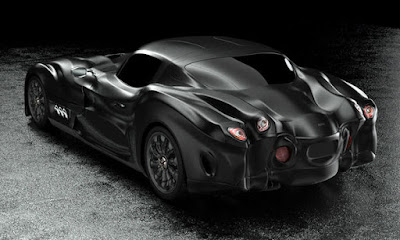The
following eccentric car concept named the Alessian 2012 is one of the
works created by a Slovakian automotive designer named Ivan Venkov in
2012. Looking at the odd-shaped at a glance, it might suddenly made you remind to the Japanese odd-looking car named Mitsuoka Orochi, but Ivan Venkov's creation is even more weird than the Japs car mentioned above.
 |
| The sinister looking of the Slovak's concept car named Alessian 2012 is designed by Ivan Venkov. (Picture from: https://bit.ly/3lrw9hw) |
Look at the entire the car's front fascia is filled with sinister curves that resembles the hell-guardian sharp-silver nails. Its sinister form becomes even more perfect with the black dark color cast applied to the entire body of it, making it to be a perfect companion to the most sinister devil ever.
The Alessian 2012 may be nothing more than a creepy concept car even according to some people it looks very ugly. Well, it looks ugly at first glance ... but it's not.
 |
| Front view of the Alessian 2012 concept car designed by Ivan Venkov. (Picture from: https://bit.ly/3lrw9hw) |
As quoted from Jalopnik, the designer cleverly applied a few elements taken from the H.R. Giger silhouette into several parts of the concept car. Adding by the long snout proportions of a late 1930s BMW figure with all those crazy organic lines, echoing and distorting so in a second able to change your mind and idea of what the coupé should look like.
According to the designer "The concept represents a complex approach to shaping in automotive design. The shapes are stretched over the chassis of the car as muscles, generating contrasting appeal and energy sweeping around the car's body.
 |
| Top view of the Alessian 2012 concept car designed by Ivan Venkov.. (Picture from: https://bit.ly/3lrw9hw) |
'Today’s production hasn’t surpassed the past in complexity of aesthetics, yet the technologies have evolved greatly' is what designer Venkov gives as the rationale behind his car and complexity in aesthetics it certainly has in spades. Also, an odd number of extravagant sidepipes. Which is a good thing.
 |
| Rear three-quarter of the Alessian 2012 concept car designed by Ivan Venkov.. (Picture from: https://bit.ly/3lrw9hw) |
Thanks to Ivan Venkov for the images. You can see another Ivan Venkov's creations on his Behance pages. Are you wanna ride along with this creepiest car all of time on this year's halloween? Grabs the blanket and bury your body behind it, the car will be coming in Your nightmares tonight. *** [EKA | FROM VARIOUS SOURCES | JALOPNIK | SPICYTEC | BEHANCE ]
Note: This blog can be accessed via your smart phone.




























